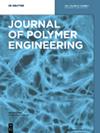干式多孔聚二甲基硅氧烷(PDMS):一种以樟脑为支架的新方法
IF 1.7
4区 工程技术
Q4 POLYMER SCIENCE
引用次数: 0
摘要
最佳的便携式微流体设备应确保最少的附件数量,以实现多功能的现场应用。通常情况下,在这种用聚二甲基硅氧烷(PDMS)制造的装置中,流体的传输是通过一种非常规的泵送机制来实现的。事实证明,这种泵送系统可以利用聚二甲基硅氧烷(PDMS)相对较高的透气性来输送小体积流体。最近,微孔 PDMS 取代了 PDMS 的这一功能。微孔 PDMS 通常是通过一系列步骤制造出来的,其中使用牺牲模板渗入聚合物。聚合物固化后,再将模板移除。这种方法始终会产生一种非刚性、粘性和潮湿的海绵状结构,使其变得笨重。在这项工作中,我们提出了一个新概念,即使用樟脑(Cinnamomum camphora)作为模板来制造干聚合物海绵。拟议中的海绵是在可升华材料樟脑上成型的,从而避免了模板溶解的额外步骤。实验证明,这种海绵既坚硬又柔韧,便于在狭小空间内压缩。此外,与通过糖浸出产生的结构相比,这种海绵干燥且不粘。本文章由计算机程序翻译,如有差异,请以英文原文为准。
Dry porous polydimethylsiloxane (PDMS): a novel method using camphor as scaffold
An optimal portable microfluidic device should ensure least number of accessories for versatile field application. Typically, in such a device fabricated with polydimethylsiloxane (PDMS), the transport of fluid is enabled through a nonconventional pumping mechanism. This pumping system has been demonstrated to utilize the relatively high air permeability of polydimethyl siloxane (PDMS) to transport small volume fluid. In the recent past, microporous PDMS has replaced PDMS in this capacity. Microporous PDMS is typically fabricated through a series of steps where a sacrificial template is used to infiltrate the polymer. This template is removed after the polymer undergoes curing. This method has consistently produced a spongy structure that is nonrigid, sticky, and moist rendering it unwieldy. In this work, we present a novel concept of using camphor (Cinnamomum camphora ) as a template to fabricate a dry polymeric sponge. The proposed sponge is molded on a sublimable material, camphor to avoid the additional step of template dissolution. The sponge is demonstrated to be stiff yet flexible rendering it convenient to be compacted into a confined space. Additionally, the sponge is dry and nonsticky as compared to structures that have been generated through sugar leaching.
求助全文
通过发布文献求助,成功后即可免费获取论文全文。
去求助
来源期刊

Journal of Polymer Engineering
工程技术-高分子科学
CiteScore
3.20
自引率
5.00%
发文量
95
审稿时长
2.5 months
期刊介绍:
Journal of Polymer Engineering publishes reviews, original basic and applied research contributions as well as recent technological developments in polymer engineering. Polymer engineering is a strongly interdisciplinary field and papers published by the journal may span areas such as polymer physics, polymer processing and engineering of polymer-based materials and their applications. The editors and the publisher are committed to high quality standards and rapid handling of the peer review and publication processes.
 求助内容:
求助内容: 应助结果提醒方式:
应助结果提醒方式:


